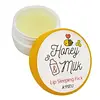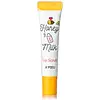What's inside
What's inside
 Key Ingredients
Key Ingredients

 Benefits
Benefits

 Concerns
Concerns

 Ingredients Side-by-side
Ingredients Side-by-side

Petrolatum
EmollientParaffinum Liquidum
EmollientPolybutene
Microcrystalline Wax
Emulsion StabilisingSilica Silylate
EmollientParaffin
PerfumingHoney Extract
HumectantMilk Protein Extract
Glycerin
HumectantPolyethylene
AbrasiveVp/Hexadecene Copolymer
Methyl Hydrogenated Rosinate
PerfumingTocopheryl Acetate
AntioxidantDiisostearyl Malate
EmollientPolyglyceryl-2 Triisostearate
EmulsifyingWater
Skin ConditioningPropylene Glycol
HumectantDehydroacetic Acid
PreservativePhenoxyethanol
PreservativeParfum
MaskingCI 77891
Cosmetic ColorantCI 19140
Cosmetic ColorantPetrolatum, Paraffinum Liquidum, Polybutene, Microcrystalline Wax, Silica Silylate, Paraffin, Honey Extract, Milk Protein Extract, Glycerin, Polyethylene, Vp/Hexadecene Copolymer, Methyl Hydrogenated Rosinate, Tocopheryl Acetate, Diisostearyl Malate, Polyglyceryl-2 Triisostearate, Water, Propylene Glycol, Dehydroacetic Acid, Phenoxyethanol, Parfum, CI 77891, CI 19140
Water
Skin ConditioningParaffinum Liquidum
EmollientJuglans Regia Shell Powder
AbrasiveCetearyl Alcohol
EmollientGlyceryl Stearate
EmollientPolysorbate 60
EmulsifyingHoney Extract
HumectantMilk Protein Extract
Glycerin
HumectantStearic Acid
CleansingPEG-100 Stearate
1,2-Hexanediol
Skin ConditioningSorbitan Stearate
EmulsifyingHydroxyethyl Acrylate/Sodium Acryloyldimethyl Taurate Copolymer
Emulsion StabilisingDimethicone
EmollientCaprylyl Glycol
EmollientTriethanolamine
BufferingSqualane
EmollientTocopheryl Acetate
AntioxidantSorbitan Isostearate
EmulsifyingCyclopentasiloxane
EmollientDimethicone/Vinyl Dimethicone Crosspolymer
Skin ConditioningCarbomer
Emulsion StabilisingPhenoxyethanol
PreservativeDisodium EDTA
Parfum
MaskingCI 77891
Cosmetic ColorantWater, Paraffinum Liquidum, Juglans Regia Shell Powder, Cetearyl Alcohol, Glyceryl Stearate, Polysorbate 60, Honey Extract, Milk Protein Extract, Glycerin, Stearic Acid, PEG-100 Stearate, 1,2-Hexanediol, Sorbitan Stearate, Hydroxyethyl Acrylate/Sodium Acryloyldimethyl Taurate Copolymer, Dimethicone, Caprylyl Glycol, Triethanolamine, Squalane, Tocopheryl Acetate, Sorbitan Isostearate, Cyclopentasiloxane, Dimethicone/Vinyl Dimethicone Crosspolymer, Carbomer, Phenoxyethanol, Disodium EDTA, Parfum, CI 77891
Ingredients Explained
These ingredients are found in both products.
Ingredients higher up in an ingredient list are typically present in a larger amount.
Ci 77891 is a white pigment from Titanium dioxide. It is naturally found in minerals such as rutile and ilmenite.
It's main function is to add a white color to cosmetics. It can also be mixed with other colors to create different shades.
Ci 77891 is commonly found in sunscreens due to its ability to block UV rays.
Learn more about CI 77891Glycerin is already naturally found in your skin. It helps moisturize and protect your skin.
A study from 2016 found glycerin to be more effective as a humectant than AHAs and hyaluronic acid.
As a humectant, it helps the skin stay hydrated by pulling moisture to your skin. The low molecular weight of glycerin allows it to pull moisture into the deeper layers of your skin.
Hydrated skin improves your skin barrier; Your skin barrier helps protect against irritants and bacteria.
Glycerin has also been found to have antimicrobial and antiviral properties. Due to these properties, glycerin is often used in wound and burn treatments.
In cosmetics, glycerin is usually derived from plants such as soybean or palm. However, it can also be sourced from animals, such as tallow or animal fat.
This ingredient is organic, colorless, odorless, and non-toxic.
Glycerin is the name for this ingredient in American English. British English uses Glycerol/Glycerine.
Learn more about GlycerinThis ingredient comes from honey made by bees. It is hydrating, antibacterial, anti-aging, and skin soothing.
Honey also contains amino acids, peptides, Vitamins A, C, and E.
The humectant property of honey draws moisture from the air to your skin. This makes it great at helping to hydrate the skin.
Honey may help reduce the signs of aging due to its antioxidant properties. Fun fact: darker honey has more antioxidants than light honey. The antibacterial property of honey may make it effective at helping to treat acne by killing acne-causing bacteria.
Many people wonder if honey extract is vegan. It is technically a byproduct from bees. This is because honey is created from the digestive enzymes in a bee's stomach.
Remember to be kind to bees :) They are important for many ecosystems and are endangered.
Learn more about Honey ExtractWe don't have a description for Milk Protein Extract yet.
Paraffinum Liquidum is also known as liquid paraffin. It is a type of highly refined mineral oil.
Like other oils, Paraffinum Liquidum has emollient properties. Emollients help soothe and soften the skin. By creating a barrier to trap moisture within, emollients help keep your skin hydrated.
Paraffinum Liquidum does not irritate the skin and is non-comedogenic.
Learn more about Paraffinum LiquidumParfum is a catch-all term for an ingredient or more that is used to give a scent to products.
Also called "fragrance", this ingredient can be a blend of hundreds of chemicals or plant oils. This means every product with "fragrance" or "parfum" in the ingredients list is a different mixture.
For instance, Habanolide is a proprietary trade name for a specific aroma chemical. When used as a fragrance ingredient in cosmetics, most aroma chemicals fall under the broad labeling category of “FRAGRANCE” or “PARFUM” according to EU and US regulations.
The term 'parfum' or 'fragrance' is not regulated in many countries. In many cases, it is up to the brand to define this term.
For instance, many brands choose to label themselves as "fragrance-free" because they are not using synthetic fragrances. However, their products may still contain ingredients such as essential oils that are considered a fragrance by INCI standards.
One example is Calendula flower extract. Calendula is an essential oil that still imparts a scent or 'fragrance'.
Depending on the blend, the ingredients in the mixture can cause allergies and sensitivities on the skin. Some ingredients that are known EU allergens include linalool and citronellol.
Parfum can also be used to mask or cover an unpleasant scent.
The bottom line is: not all fragrances/parfum/ingredients are created equally. If you are worried about fragrances, we recommend taking a closer look at an ingredient. And of course, we always recommend speaking with a professional.
Learn more about ParfumPhenoxyethanol is a preservative that has germicide, antimicrobial, and aromatic properties. Studies show that phenoxyethanol can prevent microbial growth. By itself, it has a scent that is similar to that of a rose.
It's often used in formulations along with Caprylyl Glycol to preserve the shelf life of products.
Tocopheryl Acetate is AKA Vitamin E. It is an antioxidant and protects your skin from free radicals. Free radicals damage the skin by breaking down collagen.
One study found using Tocopheryl Acetate with Vitamin C decreased the number of sunburned cells.
Tocopheryl Acetate is commonly found in both skincare and dietary supplements.
Learn more about Tocopheryl AcetateWater. It's the most common cosmetic ingredient of all. You'll usually see it at the top of ingredient lists, meaning that it makes up the largest part of the product.
So why is it so popular? Water most often acts as a solvent - this means that it helps dissolve other ingredients into the formulation.
You'll also recognize water as that liquid we all need to stay alive. If you see this, drink a glass of water. Stay hydrated!
Learn more about Water